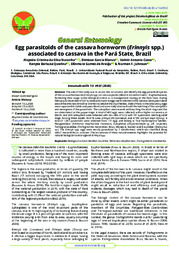Egg parasitoids of the cassava hornworm (Erinnyis spp.) associated to cassava in the Pará State, Brazil.
Egg parasitoids of the cassava hornworm (Erinnyis spp.) associated to cassava in the Pará State, Brazil.
Author(s): NORONHA, A. C. da S.; BLANCO, D. G. B.; COSTA, V. A.; SILVA, R. B. Q. da; ARAÚJO, D. G. de; JOHNSON, N. F.
Summary: The aim of this study was to assess the occurrence and identify the egg-parasitoid species of the cassava hornworm (Erinnyis spp.) in cassava plants (Manihot esculenta Crantz - Euphorbiaceae), facilitating their usage in the biological control as a management strategy in the Pará State. During February to December of 2016, cassava hornworm eggs were collected in the Cassava Germplasm Bank area of the Embrapa Amazônia Oriental, located at the city of Belém, State of Pará. In the laboratory, eggs were separated in viable and parasitized and were daily observed until the hatching of the caterpillars and emergence of the parasitoids. The caterpillars were reared until reaching the adult stage and the sex determined at the pupae stage. A total of 482 eggs were collected, with a higher occurrence at March, and 244 caterpillars were obtained with sex ratio of 0.52 with 191 specimens reaching adult stage. Among these adults, 95.81% were Erinnyis ello (Linnaeus) and 4.19% Erinnyis alope (Drury). A total of 1,087 parasitoids were obtained from 131 eggs and belong to four Hymenoptera families: Platygastridae (Telenomus dilophonotae Cameron), Eulophidae (Chrysonotomyia sp. aff. serjaniae),Trichogrammatidae (Trichogramma marandobai Brun, Moraes & Soares) and Encyrtidae (Ooencyrtus sp.). The Erinnyis spp. eggs were mostly parasitized by T. dilophonotae, which was classified along with T. marandobai as constant. The occurrence of these natural enemies highlights the potential for natural biological control against Erinnyis spp.
Publication year: 2020
Types of publication: Journal article
Unit: Embrapa Eastern Amazon
Observation
Some of Embrapa's publications are published as ePub files. To read them, use or download one of the following free software options to your computer or mobile device. Android: Google Play Books; IOS: iBooks; Windows and Linux: Calibre.
Access other publications
Access the Agricultural Research Database (BDPA) to consult Embrapa's full library collection and records.
Visit Embrapa Bookstore to purchase books and other publications sold by Embrapa.

